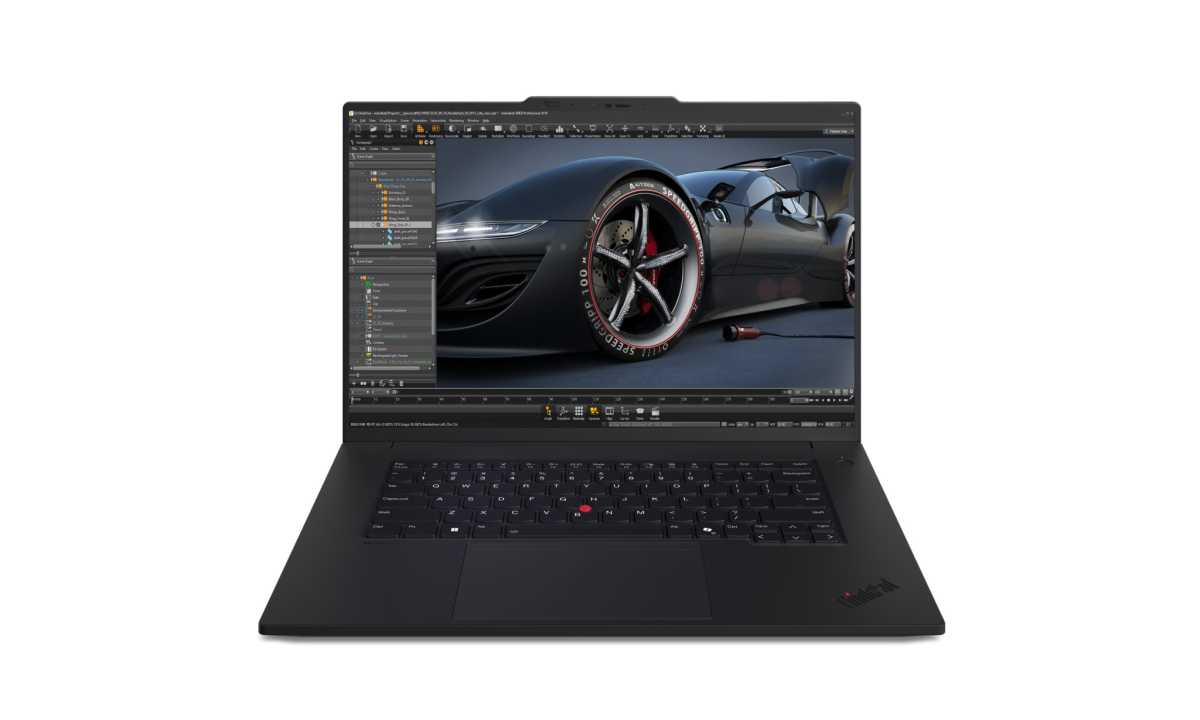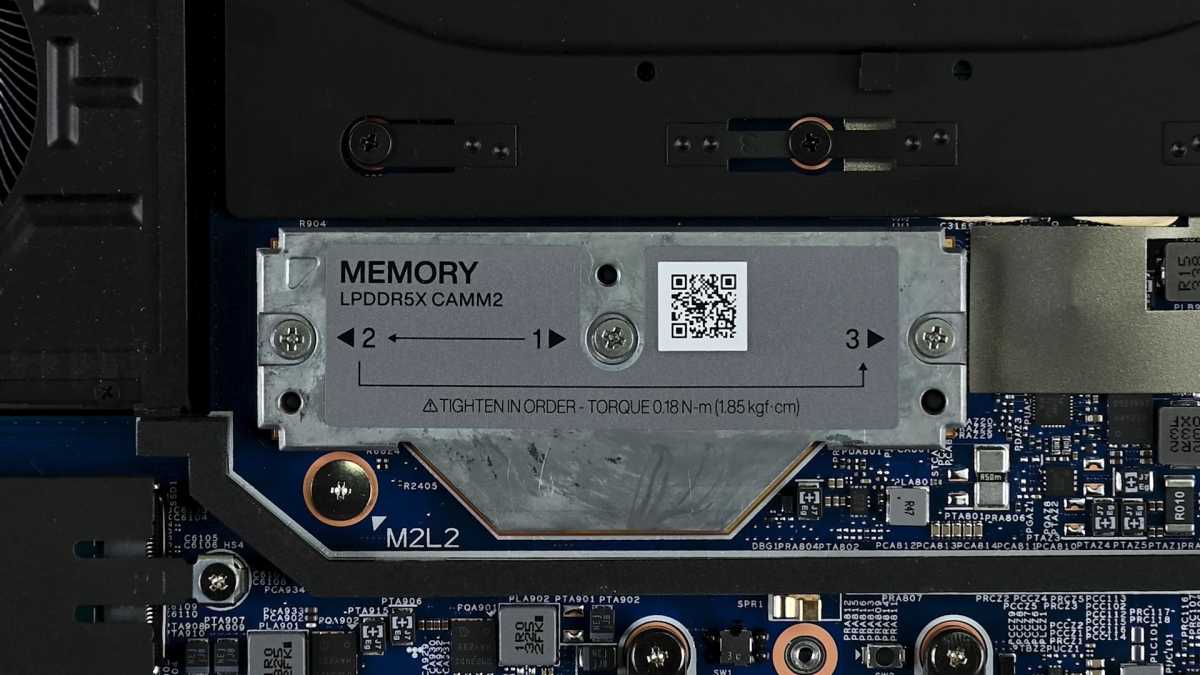MacBook buyers still fuming from Apple’s decision to sell expensive laptops with just 8GB of RAM wish they had what Lenovo’s new ThinkPad P1 has: The ability to offer fast and power efficient RAM that you can upgrade.
Upgradeable RAM in PC laptops isn’t a new thing of course, but Lenovo’s new ThinkPad P1 (announced on April 23) appears to be the first to use Micron’s LPCAMM2. LPCAMM2 is built to solve the problem that’s vexed laptops for years now: RAM power consumption.
Laptops using DDR5 SO-DIMM RAM modules typically consume a lot of space and power. LPDDR5X RAM or low-power DDR5 can save significant active and standby power and offer even better performance but its performance and power requirements require it to be soldered directly to the laptop’s motherboard as close to the CPU as possible.
After JEDEC, the organization that manages memory standards, adopted Dell’s Compression Attached Memory Module as CAMM2 last year, an offshoot of it was also developed as LPCAMM2 as well.

ThinkPad P1 with LPCAMM2 RAM
ThinkPad P1 with LPCAMM2 RAM
Lenovo
ThinkPad P1 with LPCAMM2 RAM
Lenovo
Lenovo
Micron says LPCAMM2 will hit 7467MT/s speeds, which provides about 34 percent greater bandwidth than a DDR5 module at 5600MT/s. LPCAMM2 significantly shrinks the amount of space used on the motherboard by up to 64 percent compared to a typical stacked SO-DIMM configuration.
More importantly for those interested in improved standby time and battery while used is the power savings. Micron says standby–when the lid closed–can reach 80 percent with active power usage reduction by up to 43 percent to 58 percent.
That’s compared to a 64-bit DDR5 SO-DIMM. Today’s Intel and AMD CPUs support up to 128-bit for memory so a single LPCAMM2.

Screencap from iFixit YouTube Video
Screencap from iFixit YouTube Video
iFixit
Screencap from iFixit YouTube Video
iFixit
iFixit
Apple users, of course, will point out that M3 Max in the highest-end MacBook Pro features an impressive 512-bit wide memory bus with the LPDDR5X chips mounted directly in the CPU package. To do that with LPCAMM2 would require four modules, much more space, and is likely impossible in a thin laptop.
Our dig at Apple, however, is the basic M3 features a 128-bit memory bus which would pair nicely with LPCAMM2. Rather than lock its customers into a miserly 8GB of RAM, adopting this standard could allow MacBook Air or smaller MacBook Pro users to upgrade to, say, one of Micron’s new 32GB LPCAMM2 or a 64GB LPCAMM2 modules which I’m sure every low-RAM MacBook customer would appreciate. Right? Right?!
LPCAMM2 itself has been on a slow burn news cycle for months now. Samsung initially announced it was making LPCAMM modules months before the standard was even released. SK Hynix is also aboard the LPCAMM2 train but Micron gets to toot its horn to be the first out the gate to actually show off working modules in a soon-to-ship laptop.
Repairability-rights advocate iFixit actually got to take apart the Lenovo P1 with the Micron module in a video which you can eyeball here.
It’s actually quite different from Dell’s initial CAMM proposal that we got to finger more than a year and half ago. Dell basically did the homework on CAMM to replace the antiquated 20-year-old SO-DIMM concept and then handed it over to JEDEC to ratify as an industry standard. Dell actually hoped CAMM would support both DDR5 and LPDDR5 but it’s not clear if that vision made it out of the committee.
CAMM turned into CAMM2 as the formal standard and adopted two mounting standards–a stacked design using two single-channel CAMM2 modules, or a single-module design mounting a dual-channel CAMM2 module. From examining JEDEC’s technical documents, the dual-channel features 128-bit using four 32-bit subchannels and looks to possibly be mechanically compatible with LPDDR5X–but it’s not quite clear to us yet. We can say JEDEC’s technical documents indicate CAMM2 modules using a square shape while the LPCAMM2 modules use the smaller notched module you see above.
The future is here!
The important part of the Micron and Lenovo news is we’re finally on the way to replacing SO-DIMMs — and we’re also likely to see a nice improvement in power conservation in laptops that typically don’t receive it.
For example, the ThinkPad P1 is a workstation laptop and usually would be paired with bulkier and more power hungry conventional SO-DIMMs. With Micron’s LPCAMM2, the P1 should provide you with much better standby time and do so without using soldered down, and non-upgradeable RAM which should be celebrated by all.
Laptops
Upgradeable RAM in PC laptops isn’t a new thing of course, but Lenovo’s new ThinkPad P1 (announced on April 23) appears to be the first to use Micron’s LPCAMM2. LPCAMM2 is built to solve the problem that’s vexed laptops for years now: RAM power consumption.
Laptops using DDR5 SO-DIMM RAM modules typically consume a lot of space and power. LPDDR5X RAM or low-power DDR5 can save significant active and standby power and offer even better performance but its performance and power requirements require it to be soldered directly to the laptop’s motherboard as close to the CPU as possible.
After JEDEC, the organization that manages memory standards, adopted Dell’s Compression Attached Memory Module as CAMM2 last year, an offshoot of it was also developed as LPCAMM2 as well.

ThinkPad P1 with LPCAMM2 RAM
ThinkPad P1 with LPCAMM2 RAM
Lenovo
ThinkPad P1 with LPCAMM2 RAM
Lenovo
Lenovo
Micron says LPCAMM2 will hit 7467MT/s speeds, which provides about 34 percent greater bandwidth than a DDR5 module at 5600MT/s. LPCAMM2 significantly shrinks the amount of space used on the motherboard by up to 64 percent compared to a typical stacked SO-DIMM configuration.
More importantly for those interested in improved standby time and battery while used is the power savings. Micron says standby–when the lid closed–can reach 80 percent with active power usage reduction by up to 43 percent to 58 percent.
That’s compared to a 64-bit DDR5 SO-DIMM. Today’s Intel and AMD CPUs support up to 128-bit for memory so a single LPCAMM2.

Screencap from iFixit YouTube Video
Screencap from iFixit YouTube Video
iFixit
Screencap from iFixit YouTube Video
iFixit
iFixit
Apple users, of course, will point out that M3 Max in the highest-end MacBook Pro features an impressive 512-bit wide memory bus with the LPDDR5X chips mounted directly in the CPU package. To do that with LPCAMM2 would require four modules, much more space, and is likely impossible in a thin laptop.
Our dig at Apple, however, is the basic M3 features a 128-bit memory bus which would pair nicely with LPCAMM2. Rather than lock its customers into a miserly 8GB of RAM, adopting this standard could allow MacBook Air or smaller MacBook Pro users to upgrade to, say, one of Micron’s new 32GB LPCAMM2 or a 64GB LPCAMM2 modules which I’m sure every low-RAM MacBook customer would appreciate. Right? Right?!
LPCAMM2 itself has been on a slow burn news cycle for months now. Samsung initially announced it was making LPCAMM modules months before the standard was even released. SK Hynix is also aboard the LPCAMM2 train but Micron gets to toot its horn to be the first out the gate to actually show off working modules in a soon-to-ship laptop.
Repairability-rights advocate iFixit actually got to take apart the Lenovo P1 with the Micron module in a video which you can eyeball here.
It’s actually quite different from Dell’s initial CAMM proposal that we got to finger more than a year and half ago. Dell basically did the homework on CAMM to replace the antiquated 20-year-old SO-DIMM concept and then handed it over to JEDEC to ratify as an industry standard. Dell actually hoped CAMM would support both DDR5 and LPDDR5 but it’s not clear if that vision made it out of the committee.
CAMM turned into CAMM2 as the formal standard and adopted two mounting standards–a stacked design using two single-channel CAMM2 modules, or a single-module design mounting a dual-channel CAMM2 module. From examining JEDEC’s technical documents, the dual-channel features 128-bit using four 32-bit subchannels and looks to possibly be mechanically compatible with LPDDR5X–but it’s not quite clear to us yet. We can say JEDEC’s technical documents indicate CAMM2 modules using a square shape while the LPCAMM2 modules use the smaller notched module you see above.
The future is here!
The important part of the Micron and Lenovo news is we’re finally on the way to replacing SO-DIMMs — and we’re also likely to see a nice improvement in power conservation in laptops that typically don’t receive it.
For example, the ThinkPad P1 is a workstation laptop and usually would be paired with bulkier and more power hungry conventional SO-DIMMs. With Micron’s LPCAMM2, the P1 should provide you with much better standby time and do so without using soldered down, and non-upgradeable RAM which should be celebrated by all.
Laptops
